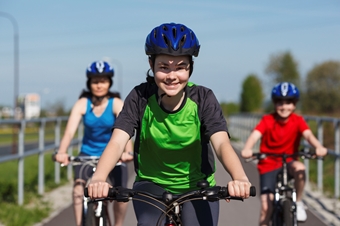Bicycling is becoming more popular as an environmentally friendly and cost effective transportation alternative as well as a fun and healthy recreational activity. Novice and experienced cyclists need to make safety a top priority. These tips will help keep you safe on the road:
-
Safety first – Safety equipment begins with the helmet. Wearing an approved helmet can reduce the risk of a head injury by up to 85-percent in the event of an accident. In addition, wear brightly colored or reflective clothing so you can be seen during the early morning and evening hours. However, avoid riding your bike at night. You should also carry a small First Aid kit in case of an emergency.

-
Keep your bike in good shape – Make sure all parts are in good repair, and check your brakes, tires and gears often. Have a bike expert teach you the basics so that you can continue routine maintenance. Your bicycle should be equipped with reflectors and lights.
-
Follow traffic laws – Bicycles are considered vehicles and cyclists should obey the same traffic laws as motorists. Travel on the right side of the road with traffic, and do not ride on the sidewalk. Obey all stop signs, traffic lights and lane markings. Use proper hand signals before making any lane changes or turns.
-
Check out other routes – Sometimes the main road may not be the safest way to travel by bike. Look into alternate routes with less motor vehicle traffic or better road conditions. Some cities have even implemented lanes for cyclists.
-
Finding the correct fit – The most important factor in bicycling is finding a bike that fits you properly. You should be able to stand just over the top bar of the bike with your feet flat on the ground. A professional at a bike shop can assist in properly fitting you with an appropriate bike.
Bicycle Commuting Benefits:
-
Your fitness level will improve. Research shows that regular cycling can cut the chance of heart disease in half.
-
Trips of less than three miles will be quicker by bike, and trips five to seven miles in urban areas may take the same time or less as by car.
-
You save money on gas and put less wear and tear on your car.
-
You are reducing your carbon footprint through less CO2 emissions.
-
In the city, it may be easier to find a place to park your bike than your car.
For more information on bicycle safety...
League of American Bicyclists: www.bikeleague.org
National Highway Traffic Safety Administration: www.nhtsa.dot.gov




















